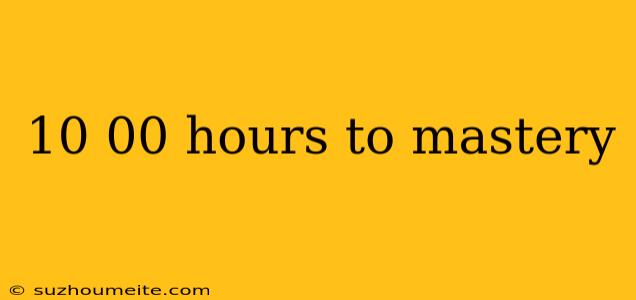10,000 Hours to Mastery: The Myth, the Legend, and the Reality
The Concept of 10,000 Hours
In 2008, Malcolm Gladwell's book "Outliers: The Story of Success" popularized the idea that it takes 10,000 hours of deliberate practice to achieve mastery in a particular field. This concept, also known as the "10,000-hour rule," has since been debated, misinterpreted, and even worshipped by many. But what does it really mean, and is it a guaranteed path to success?
The Origin of the 10,000-Hour Rule
The idea of 10,000 hours originated from a 1993 study by Anders Ericsson, a Swedish psychologist, who researched the practice habits of violinists at the Music Academy of West Berlin. Ericsson found that the most accomplished violinists had accumulated around 10,000 hours of deliberate practice by the time they reached expertise. However, this study was misinterpreted, and the rule has since been oversimplified and misapplied.
Debunking the Myth
The 10,000-hour rule is not a magical number that guarantees success. It's not a one-size-fits-all formula that applies to every individual or field. Many factors influence the development of expertise, including:
- Individual differences: People learn and progress at different rates.
- Quality of practice: Simply clocking hours doesn't ensure mastery; the quality of practice matters.
- Deliberate practice: Focus on improving specific aspects of performance, rather than mere repetition.
- Feedback and guidance: Working with a skilled coach or mentor can significantly accelerate progress.
- Intrinsic motivation: Passion and enjoyment of the activity drive consistent effort and improvement.
The Reality of Mastery
Mastery is a lifelong process that requires dedication, persistence, and resilience. It's not a destination, but a continuous journey of learning and improvement. The 10,000-hour rule should be viewed as a rough estimate, rather than a rigid benchmark.
Real-Life Examples
- Bobby Fischer: The chess grandmaster reportedly spent around 11,000 hours studying chess before becoming a world champion at 29.
- Steve Jobs: Co-founder of Apple, Jobs spent decades honing his skills in design, innovation, and entrepreneurship.
- Serena Williams: The tennis superstar has spent countless hours on the court, perfecting her technique and strategy.
Conclusion
The 10,000-hour rule is a fascinating concept, but it's essential to understand its limitations and nuances. Mastery is a complex, multifaceted process that demands more than just clocking hours. It requires dedication, passion, and a willingness to continuously learn and improve. While 10,000 hours may be a rough estimate, the true secret to success lies in embracing the journey, not just the destination.
